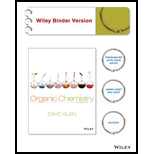
(a)
Interpretation:
For the given set of molecules the optically active or optically inactive should be identified.
Concept Introduction:
Enantiomers are chiral molecules that are mirror images of one another. The molecules are non-superimposable on one another.
Optically active: These are capable of rotating the plane of polarized light to the right or left either dextrorotatory or levorotatory used of compounds, molecules, or atoms.
Optically inactive: A racemic mixture is an optically inactive; there is no net rotation of plane-polarized light. Although the two enantiomers rotate plane-polarized light in opposite directions, the rotations cancel because they are present in equal amounts.
(b)
Interpretation:
For the given set of molecules the optically active or optically inactive should be identified.
Concept Introduction:
Enantiomers are chiral molecules that are mirror images of one another. The molecules are non-superimposable on one another.
Optically active: These are capable of rotating the plane of polarized light to the right or left either dextrorotatory or levorotatory used of compounds, molecules, or atoms.
Optically inactive: A racemic mixture is an optically inactive; there is no net rotation of plane-polarized light. Although the two enantiomers rotate plane-polarized light in opposite directions, the rotations cancel because they are present in equal amounts.
(c)
Interpretation:
For the given set of molecules the optically active or optically inactive should be identified.
Concept Introduction:
Enantiomers are chiral molecules that are mirror images of one another. The molecules are non-superimposable on one another.
Optically active: These are capable of rotating the plane of polarized light to the right or left either dextrorotatory or levorotatory used of compounds, molecules, or atoms.
Optically inactive: A racemic mixture is an optically inactive; there is no net rotation of plane-polarized light. Although the two enantiomers rotate plane-polarized light in opposite directions, the rotations cancel because they are present in equal amounts.
Want to see the full answer?
Check out a sample textbook solution
Chapter 5 Solutions
Organic Chemistry, Binder Ready Version
- What alkene or alkyne yields the following products after oxidative cleavage with ozone? Click the "draw structure" button to launch the drawing utility. draw structure ... andarrow_forwardDraw the products of the stronger acid protonating the other reactant. H3C-C=C-4 NH2 KEq CH H3C `CH3 Product acid Product basearrow_forward2. Draw the missing structure(s) in each of the following reactions. The missing structure(s) can be a starting material or the major reaction product(s). C5H10 Br H-Br CH2Cl2 + enant.arrow_forward
- Draw the products of the stronger acid protonating the other reactant. KEq H₂C-O-H H3C OH Product acid Product basearrow_forwardDraw the products of the stronger acid protonating the other reactant. OH KEq CH H3C H3C `CH3 Product acid Product basearrow_forward2. Draw the missing structure(s) in each of the following reactions. The missing structure(s) can be a starting material or the major reaction product(s). Ph H-I CH2Cl2arrow_forward
- 3 attempts left Check my work Draw the products formed in the following oxidative cleavage. [1] 03 [2] H₂O draw structure ... lower mass product draw structure ... higher mass productarrow_forward2. Draw the missing structure(s) in each of the following reactions. The missing structure(s) can be a starting material or the major reaction product(s). H-Br CH2Cl2arrow_forwardWrite the aldol condensation mechanism and product for benzaldehyde + cyclohexanone in a base. Then trans-cinnamaldehyde + acetone in base. Then, trans-cinnamaldehyde + cyclohexanone in a base.arrow_forward
 ChemistryChemistryISBN:9781305957404Author:Steven S. Zumdahl, Susan A. Zumdahl, Donald J. DeCostePublisher:Cengage Learning
ChemistryChemistryISBN:9781305957404Author:Steven S. Zumdahl, Susan A. Zumdahl, Donald J. DeCostePublisher:Cengage Learning ChemistryChemistryISBN:9781259911156Author:Raymond Chang Dr., Jason Overby ProfessorPublisher:McGraw-Hill Education
ChemistryChemistryISBN:9781259911156Author:Raymond Chang Dr., Jason Overby ProfessorPublisher:McGraw-Hill Education Principles of Instrumental AnalysisChemistryISBN:9781305577213Author:Douglas A. Skoog, F. James Holler, Stanley R. CrouchPublisher:Cengage Learning
Principles of Instrumental AnalysisChemistryISBN:9781305577213Author:Douglas A. Skoog, F. James Holler, Stanley R. CrouchPublisher:Cengage Learning Organic ChemistryChemistryISBN:9780078021558Author:Janice Gorzynski Smith Dr.Publisher:McGraw-Hill Education
Organic ChemistryChemistryISBN:9780078021558Author:Janice Gorzynski Smith Dr.Publisher:McGraw-Hill Education Chemistry: Principles and ReactionsChemistryISBN:9781305079373Author:William L. Masterton, Cecile N. HurleyPublisher:Cengage Learning
Chemistry: Principles and ReactionsChemistryISBN:9781305079373Author:William L. Masterton, Cecile N. HurleyPublisher:Cengage Learning Elementary Principles of Chemical Processes, Bind...ChemistryISBN:9781118431221Author:Richard M. Felder, Ronald W. Rousseau, Lisa G. BullardPublisher:WILEY
Elementary Principles of Chemical Processes, Bind...ChemistryISBN:9781118431221Author:Richard M. Felder, Ronald W. Rousseau, Lisa G. BullardPublisher:WILEY





